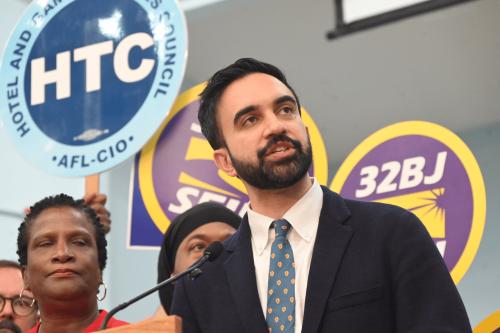The condition of the U.S. economy is alarming, as is evidenced by recent trends in the labor market. Payrolls shrunk by 533,000 jobs in November, the worst monthly figure since 1974. Since the start of the recession in December 2007, the economy has shed more than 1.9 million jobs.
The government can stimulate domestic production and revive employment by temporarily increasing the overall demand for goods and services. It can do this by increasing expenditures or decreasing taxes, as proposed by President-elect Barack Obama as part of his economic recovery plan.
It is reasonable to ask whether accumulating large amounts of new debt is wise, especially since problems in the credit market are at the core of the current crisis. However, the process of issuing new Treasury bills to finance spending now with principal to be paid back out of future tax receipts is a simple, well-understood process. It is much different and much less risky than the complex financial engineering whose backlash has devastated our financial sector.
Somewhat ironically, the flight to safety induced by the credit crisis also means the government can currently borrow funds relatively cheaply. Meanwhile, the losses to individuals and families from lost jobs, reduced wages and other impacts of the downturn are already beginning to accumulate, and absent intervention are likely to be collectively enormous. Borrowing from the future in order to avert or mitigate those losses today is an investment worth making.
That said, efforts to stimulate the economy that are relatively fiscally efficient – in terms of their anticipated effect on GDP per dollar of expenditure – are certainly to be preferred to less-efficient efforts. Analysts ranging from the Congressional Budget Office to Mark Zandi of Moody’s Economy.com conclude that new spending will stimulate aggregate demand far more effectively than tax changes. These estimates suggest, for example, that spending on infrastructure will increase GDP by approximately 23 percent more than a temporary reduction of the payroll tax of equal magnitude. The most fiscally efficient stimulus would be composed primarily, if not entirely, of additions to spending, as opposed to tax cuts.
The package Mr. Obama has proposed is largely, but not entirely, on the mark. While it reportedly will consist principally of new spending, indications are that the middle-class tax cut promised during the campaign remains on the table. This tax cut is unlikely to have much, if any, stimulative effect. Middle-income workers, facing deteriorating economic conditions and rising expectations of deflation, are likely to save much of any tax cut.
The spending that Mr. Obama has proposed thus far is chiefly on projects that might be broadly labeled as infrastructure improvement: upgrading federal buildings, investing in roadways and bridges, modernizing public school facilities, expanding broadband access, and adopting health information technology. Spending in these areas can both stimulate the economy and serve valuable public needs, but only if done carefully.
The main concern with these types of projects is whether they can begin quickly enough to be effective as stimulus. The economy requires immediate support, but building bridges and rehabilitating schools takes time. The solution is to direct this spending toward small, short-term projects – such as repair and maintenance work – that are “shovel ready,” and to include oversight provisions to ensure this takes place. The Obama proposal emphasizes these goals and structures funding so as to favor projects that begin quickly.
Infrastructure spending is attractive as stimulus because it has the capacity to absorb large expenditures. Accelerating infrastructure spending into the next year or two is one of the few productive ways to spend the vast sums needed to adequately stimulate the economy. While expenditures on other items that will presumably be part of any final stimulus package, such as food stamps, Medicaid and unemployment insurance, are also well targeted, they alone cannot accommodate the necessary level of spending.
One unwanted side effect, however, is that it is easy for pork-barrel spending to sneak into appropriations for infrastructure improvements. The Bridge to Nowhere, after all, was an infrastructure project. Every effort should be made to prioritize projects that would meet standard cost-benefit tests. While the president-elect has promised to monitor spending to promote effectiveness, the implementation details remain vague.
A related concern about spending on infrastructure is that it appears to disproportionately benefit only a handful of industries, such as construction. However, the effects of a government injection of money into the economy do not stop with the initial recipients. Spending on infrastructure will not only benefit workers employed in that sector, but will also generate second-order effects as those workers spend their paychecks on things like food and clothing, improving economic conditions for workers employed providing the goods and services they consume.
One way to mitigate some of these potential problems and concerns is to diversify the targets of stimulus dollars to include areas outside of physical infrastructure. In particular, the Obama plan would be more robust were it to include investments in human capital as well as physical capital.
This could take the form, for example, of aid to states for use maintaining the level of services at their public universities and community colleges or offering personal vouchers to be used for job-training services on top of unemployment-insurance benefits.
Spending with the object of helping workers to upgrade their skills is not only a relatively high return investment at times of high unemployment and underemployment, but will also pay off when the economy does rebound and beneficiaries are better able to take advantage of the economic opportunities afforded by the recovery.
Overall, the Obama stimulus proposal gets the big things right. It looks to boost aggregate demand as fast as possible, using programs that get the biggest bang for the buck and keeping waste to a minimum. The time to act is now.
The Brookings Institution is committed to quality, independence, and impact.
We are supported by a diverse array of funders. In line with our values and policies, each Brookings publication represents the sole views of its author(s).



Commentary
Op-edThe Economy Needs a Shot In the Arm
December 21, 2008